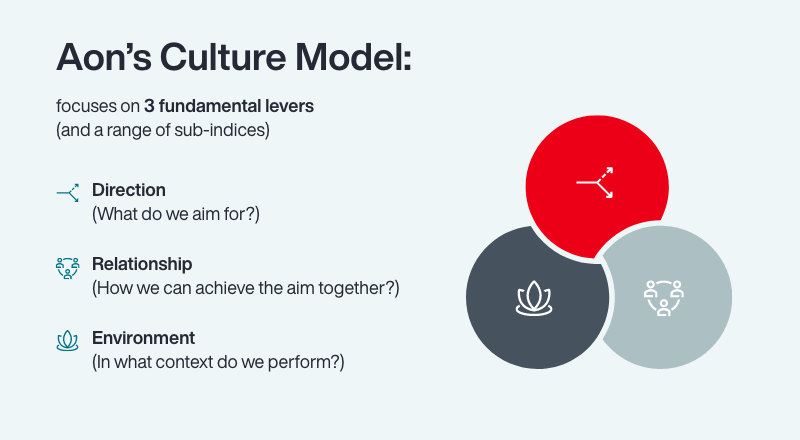The Impact of Organisational Culture on Business Performance
Building a resilient workforce
Organisational culture can have a significant impact on business performance. The key is ensuring that your organisational culture is strongly aligned to your business goals.
Key takeaways:
- Organisational culture can either enable or inhibit organisational growth and any transformation initiative
- The culture conversation is especially important when a business is seeking growth or change, or addressing. existing challenges
- There is a systematic and data-driven process for defining, aligning and reviewing organisational culture
Organisational culture can be challenging to define. Culture directs how work is done in any organisation. Beyond visible behaviour, practices and work environment, it also encompasses intangible markers like norms, attitudes, principles, unwritten rules and etiquette. It determines the unique way in which any organisation accomplishes its business goals, and shapes how it interacts with employees, clients, partners, vendors and shareholders, and even society and the environment.
Understanding Your Organisational Culture
Questions to consider:
- Do employees take accountability for their work?
- Do teams collaborate efficiently?
- How transparent are decision-making processes?
- Are leaders risk averse?
- How is work-life balance perceived?
- How does the sense of ownership compare across different organisational levels?
Why Organisational Culture Matters
Understanding organisational culture is important because an organisation’s performance is deeply rooted in how it operates. For example, a company that operates in a rapidly changing market must be able to make quick decisions and respond with agility.
Organisations with a culture aligned to their purpose and business goals are likely to perform better than average. For example, our Engagement 2.0 Study found:
4.4x
higher revenue in organisations with high cultural alignment
4x
higher EBITDA in organisations with high cultural alignment
4%
lower attrition in organisations with high cultural alignment
13%
more likely to have employees recommend their company
6%
higher first-year retention in organisations with high cultural alignment
- Better talent outcomes: Culture is an integral part of the employee experience, contributing to motivation at every organisational level. Our Engagement 2.0 Study found:
- M&A integration success: Having poorly aligned cultures is among the primary causes of M&A deal failure and 95% of executives surveyed in our Engagement 2.0 Study found that culture fit is critical to a successful integration.
“Organisations with strong culture maintain a high sense of belonging, keep a strong competitive position and derive high business results by delivering better towards employee and customer needs even while facing a volatile business environment.”
Maggie You, Aon’s Partner and Head of People Advisory & People Analytics, APAC
When Should Organisational Culture be Reviewed?
Since culture alignment is the precursor to any kind of organisational change, the best opportunity to review culture is:
- Before design/implementation of new business strategies, especially where people priorities are a key element
- Before any change in strategy, reorganisation, entering a new segment / market / geography, or any M&A deal
- After a new C-level stakeholder joins the company, looking for innovation and change in people strategy
- When start-ups look to define their identity and drive growth
- When organisations are going through existing people problems like high attrition, low engagement, and inability to attract talent
- If there is external market pressure on talent and rewards. For example, inflation.
- If the organisation is keen to differentiate where the industry brand was impacted, such as during layoffs in the tech sector.
Aligning Organisational Culture: A Systematic, Data-driven Process
To align cultures, companies should begin with a systematic diagnostic process that uses standardised metrics. Our Culture Assessment Tool can help leaders kick-start a culture conversation and identify issues.
Our Culture Assessment Tool collects data on all relevant aspects of your organisation’s culture via sub-indices that describe cultural traits and are then grouped under three headings, as below:

Four Steps to Cultural Alignment
As well as identifying gaps in cultural alignment, our Culture Assessment tool provides valuable data that can help organisations establish benchmarks and better understand the competitive features of specific industry sectors. The data this yields features heavily in our 4-step process for helping organisations achieve strong cultural alignment.
The first step is determining the current state of cultural alignment and identifying gaps through data collection and high-level diagnostic analysis. We focus on cultural levers, including governance, performance, development, and culture alignment within the leadership team.
Based on the assessment data, we define the organisation’s core values and competencies, and review cultural levers and relevant policies. This allows for a gap analysis to be conducted on current versus desired culture, as well as employee versus leadership expectations.
The next step is aligning organisational culture with business strategy. In line with the latest workforce-of-the-future trends, we develop an integrated culture transformation roadmap encompassing organisational change, communication and change management principles. Selected policies are redesigned, project champions are trained, and actionable next steps are discussed – because culture is part of a wider people strategy.
Progress monitoring and pulse checks are designed to ensure that the roadmap stays on target.
- Step 1: Data Collection and Diagnosis
- Step 2: Data-driven Analysis
- Step 3: Culture Alignment
- Step 4: Monitoring and Review
To learn more about understanding and improving your company culture, please
contact us.